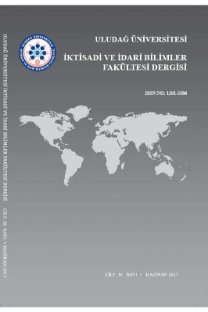Stock market uncertainty and monetary policy reaction function: Evidence from Turkey
Hisse senedi belirsizliği ve para politikası reaksiyon fonksiyonu: Türkiye örneği
___
Akyüz Y. (1973), Money and Inflation in Turkey: 1950-1968, Ankara Üniversitesi Siyasal Bilgiler Fakültesi Yayınları "No. 361, Ankara.Antonio, F., Kannan P., Rabanal P., and Scott A. (2009), "Lessons for Monetary Policy from Asset Price Fluctuation", World Economic Outlook, Chapter 3, 93-120.
Bernanke, B. and Gertler M. (1989), "Agency Costs, Net Worth, and Business Fluctuations", The American Economic Review, 79(1), 14-31.
Bernanke, B. and Gertler M. (2001), "Should Central Banks Respond to Movements in Asset Prices?", American Economic Review, 91(2), 253-257
Bernanke, B. S. and Gertler M. (1999), "Monetary Policy and Asset Price Volatility", Federal Reserve Bank of Kansas City Economic Review, 99(4), 17-51.
Bernanke, B. S., Gertler M„ and Gilchrist S. (1999), "The Financial Accelerator in a Quantitative Business Cycle Framework", Handbook of Macroeconomics in: Taylor J and Woodford M (ed), Vol. 1 chp 21, 1341-1393.
Bollerslev, T. (1986), "Generalized Autoregressive Conditional I-leteroskedasticity", Journal of Econometrics, 3 1(3), 307-327.
Borio C. and Lowe P. (2002), "Asset Prices and Monetary Stability: Exploring The Nexus", Bis Working Papers, No. 114.
Box G. E. P. and Jenkins G. M. (1976), Time Series Analysis Forecasting and Control San Francisco: Flolden-Day,
Buttimer R. J. (2011), "The Financial Crisis: Imperfect Markets and Imperfect Regulation", Journal of Financial Economic Policy, 3(1), 12-32.
CBRT, Annual Report, 2005.
CBRT, Financial Stability Report, 2010.
Cecchetti, S, Genberg H, and Wadhwani S. (2002), "Asset Prices in A Flexible Inflation Targeting Framework", NBER Working Papers, No. 8970.
Chadra, J, Sarno L. and Valente G. (2003), "Monetary Policy Rules, Asset Prices and Exchange Rates", CDMA, No. 04/03.
Clarida, R., Gali, J., and Gertler, M. (1998), "Monetary Policy Rules in Practice: Some International Evidence", European Economic Review, 42(6), 1033-1067.
Clarida, R., Gali, J., and Gertler, M. (1999), "The Scince of Monetary Policy: A New Keynesian Perspective", Journal of Economic Literature, 37(4), 1661-1707.
Clarida, R., Gali, J., and Gertler, M. (2000), "Monetary Policy Rules and Macroeconomic Stability: Evidence and Some Theory", The Quarterly Journal of Economics, 115(1), 147-180.
Crockett A. (1997), "Why is Financial Stability A Goal of Public Policy", Federal Reserve of Kansas City Proceedings, 7-36.
Engle, R. F. (1982), "Autoregressive Conditional Fleteroskedasticity with Estimates of the Variance of U.K. Inflation", Econometrica, 50(4), 987-1008.
Fisher, I. (1932), Booms and Depressions, New York: Adelphi Company.
Fisher, I. (1933), "The Debt-Deflation Theory of Great Depressions", Econometrica, 1(4), 337-357.
Fisher, I. (1982), The Rate of Interest, New York and London: Garland Publishing, Inc.
Friedman, M. and Schwartz A. J.,(1963), A Monetary History of the United States 1867-1960, Princeton: Princeton University Press.
Gerclesmeier, D., Reimers H., and Roffıa B. (2009), "Asset Price Misalignments and the Role of Money and Credit", ECU Working Papers, No. 1068.
Gruen D., Plumb M., and Stone A. (2005), "How Should Monetary Policy Respond to Asset Price Bubbles", International Journal of Central Banking, 1(3), 1-31.
Hansen, L. (1982), "Large Sample Properties of Generalized Method of Moments Estimators", Econometrica, 50(4), 1029-1054.
Jovanovic, M., and Zimmermann T. (2008), "Stock Market Uncertainty and Monetary Policy Reaction Functions of the Federal Reserve Bank", Ruhr Economic Papers, No,77.
Kontonikas A. and Ionnidis C. (2004), "Should Monetary Policy Respond to Asset Price Misalignments", Econ WPA, No. 0404026.
Minsky, H. (2008), Stabilizing an Unstable Economy, New York: McGravv Hill.
Mishkin, F.S, and White E. N. (2002), "U.S. Stock Market Crashes and Their Aftermath: Implications For Monetary Policy" NBER Working Paper 8992.
Özatay F. (2000), "A Quarterly Macroeconometric Model for a Highly Inflationary and Indebted Country: Turkey", Economic Modelling, 17, 1-11.
Özatay F. (2009), "Enflasyon ve Para Politikası", Ed., N. Özkaramete Çoşkun (in) Türkiye Ekonomisi Yeni Yapı, İmaj Yayınevi, 1-34.
Taylor, J. (1993), "Discreation Versus Policy Rules In Practice". Carnegie-Rochester Confer ende Series on Public Policy, 39, 195-214.
Taylor, J. (2007), "Housing and Monetary Policy", NBER Working Papers, No. 13682.
Yazgan, E. and Yılmazkuday, H. (2007). "Monetary Policy Rules in Practice: Evidence from Turkey and Israel", Applied Financial Economics, 17(1), 1-8.
- ISSN: 1301-3386
- Yayın Aralığı: Yılda 2 Sayı
- Başlangıç: 2018
Enerji tarz güvenliğini etkileyen ekonomik, siyasi ve coğrafi faktörler
Öğrenen örgüt yaklaşımının ilköğretim okulları açısından değerlendirilmesi
Sedat YUMUŞAK, HARUN YILDIZ, BORA YILDIZ
Avrupa birliğin'de bölgesel yelinik sistemlerine yönelik kamu politikaları:Seçilmiş ülke örnekleri
Zehra BAŞKAYA, BURCU AVCI ÖZTÜRK
Stock market uncertainty and monetary policy reaction function: Evidence from Turkey
Mehmet NARGELEÇEKENLER, ADANUR Nejle AKLAN
Enerji tüketiminin ekonomik büyüme üzerindeki etkisi: Türkiye örneği
Hastane kliniğinde kaynak dengelem amaçlı bir benzetim modeli uygulaması
H. Kemal SEZEN, Şule KAYA, Murat GÜNALI
Mükelleflerin e-vergileme sistemini benimsemelerini etkileyen faktörlerin analizi: Bursa araştırması
TOLGA DEMİRBAŞ, ADNAN GERÇEK, FİLİZ GİRAY, Mehmet YÜCE, Ayşe OĞUZLAR
